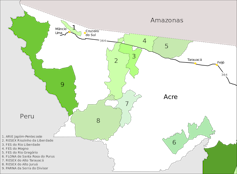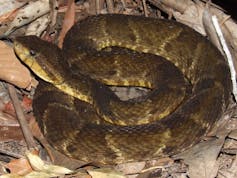Brazil records an average of 29,000 snakebites a year, leading to around 130 deaths. And it is in the Amazon that the greatest number of cases occur. This region is home to 38 of the 75 species of venomous snakes recorded in Brazil.
In the event of a snakebite in a remote area of the Amazon, some questions become very important: what is the composition of the venom? Do commercially available serums effectively neutralise this venom? Is there a distribution of these antivenoms in the region? How can the local effects of bites be treated?
To answer these questions, the first step is to study the venoms of snakes in the region. To do this, researchers need to have access to the snakes.
This is where the multidisciplinary study I am coordinating comes in. A team of herpetologists and other professionals that I am part of searches for venomous snakes in forests in the state of Acre and sends the live specimens to the Butantan Institute for study.
The project aims to gain more knowledge about the composition of Amazonian snake venoms and assess whether these venoms are recognised by commercial antivenoms. In addition, the project proposes adjuvant treatments (administered in addition to primary therapy to maximise its effectiveness), such as the use of enzyme inhibitors, mainly to treat the local effects of the bite. Finally, it aims to clarity the procedures for distributing antivenoms in remote areas of the Amazon.
In search of snakes
In order to carry out our research, we need to find venomous snakes in the wild. To do this, our team goes on expeditions, especially to the Serra do Divisor National Park.

Located in the Alto Juruá region, in the far west of the Brazilian Amazon, the Serra do Divisor is the most westerly point in the country and to get there you have to travel overland: 35 kilometres from Cruzeiro do Sul to the Port of Japiim, in Mâncio Lima. From the port, the journey is by boat on the Moa River and can take between 8 and 12 hours, depending on the type of boat and the time of year.
Our target of observation are the venomous snakes, those that produce venom in specialised glands and have venom-inoculating teeth that can cause poisoning in humans. In the Alto Juruá region, where we collected snakes, 12 species of venomous snakes are known: six true corals, five species of jararacas and the surucucu-pico-de-jaca.
The seriousness of an accident in a place like Serra do Divisor can be greater, due to the great distance between it and towns and hospitals. That’s why you can’t be too careful.
During expeditions, which usually last at least five days, we need to take certain precautions. As well as snakes, you need to be wary of mosquitoes that transmit diseases such as malaria and other venomous animals found in the region, such as stingrays, spiders and scorpions. Other dangers that worry us are storms when we are in the forests, because of the danger of lightning and trees that could fall.

Venomous snakes generally have nocturnal habits and to find them, herpetologists search for them at night on forest trails. At a slow pace, we look carefully on each side of the trail, using torches and observing from the ground to the top of the trees, as far as our eyes can see. Some species can be found up to 20 metres up in the branches of trees.
When we find snakes, we carefully capture them and transport them in boxes to our university, where they are then sent to the Butantan Institute in São Paulo for venom research. On some expeditions, we have captured more than 20 snakes. But in science in general and field research in particular, things don’t always turn out as expected. On our last two expeditions, in December 2023 and February 2024, we found almost half the usual number of snakes.
We believe that the recent El Niño weather event has contributed to the lower frequency of snake encounters, due to changes in the rainfall regime in the region. Our next expedition to the region is scheduled for the end of this year or the beginning of 2025.
Amazonian snakes
The elapids (a family of snakes with 41 species in Brazil) are represented in the region by the true corals. The six true corals of the Alto Juruá belong to the genus Micrurus (M. annellatus, M. bolivianus, M. lemniscatus, M. spixii e M. surinamensis). But none of them have their venom in the “pool” for the production of the (bivalent) antielapid serum, which is made from the venom of the species M. corallinus e M. frontalis, which do not occur in the Amazon.

The interest in Amazonian corals is due to the fact that the biochemical composition of these species’ venoms is relatively less studied and has some particularities. Micrurus surinamensis, for example, unlike other corals, does not feed on amphisbaenians (reptiles popularly known as blind snakes or two-headed snakes) and other snakes, but mainly on fish. As a result, this species has a venom with certain specialisations, aimed at subduing fish, as well as having other types of prey.

Viperids (the family of venomous snakes that includes jararacas, rattlesnakes and the surucucu-pico-de-jaca) are of great interest in this research, since this group is the main cause of snakebite accidents in Brazil. The main snake causing envenomations in the Amazon is the jararaca (Bothrops atrox) and it is the most common snake in the region, found in various types of habitats.
The papagaia (B. bilineatus), which has arboreal habits, stands out for its green colouring, which provides camouflage among the foliage of forest trees. It is one of the species that can be found on branches up to 20 metres high.
Three other species of jararacas - Bothrocophias hyoprora, B. brazili and B. taeniatus - are more difficult to find because they live in terra firme forests and occur in lower population densities.

And then there’s the surucucu-pico-de-jaca (Lachesis muta), the largest venomous snake in South America, which can reach 3.15 metres in length and occurs in low population density in terra firme forests. For this reason, encounters with them are also infrequent.
Knowing more about these snakes can help us produce more effective treatments that are better distributed throughout the Amazon region.


